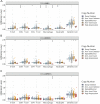Exploration of the Tumor Mutational Burden as a Prognostic Biomarker and Related Hub Gene Identification in Prostate Cancer
- PMID: 34806485
- PMCID: PMC8606726
- DOI: 10.1177/15330338211052154
Exploration of the Tumor Mutational Burden as a Prognostic Biomarker and Related Hub Gene Identification in Prostate Cancer
Abstract
To explore the signature function of the tumor mutational burden (TMB) and potential biomarkers in prostate cancer (PCa), transcriptome profiles, somatic mutation data, and clinicopathologic feature information were downloaded from The Cancer Genome Atlas (TCGA) database. R software package was used to generate a waterfall plot to summarize the specific mutation information and calculate the TMB value of PCa. Least absolute shrinkage and selection operator (LASSO) Cox regression analysis was used to select the hub genes related to the TMB from the ImmPort network to build a risk score (RS) model to evaluate prognostic values and plot Kaplan-Meier (K-M) curves to predict PCa patients survival. The results showed that PCa patients with a high TMB exhibited higher infiltration of CD8+ T cells and CD4+ T cells and better overall survival (OS) than those with a low TMB. The anti-Mullerian hormone (AMH), baculoviral IAP repeat-containing 5 (BIRC5), and opoid receptor kappa 1 (OPRK1) genes were three hub genes and their copy number variation (CNV) was relatively likely to affect the infiltration of immune cells. Moreover, PCa patients with low AMH or BIRC5 expression had a longer survival time and lower cancer recurrence, while elevated AMH or BIRC5 expression favored PCa progression. In contrast, PCa patients with low OPRK1 expression had poorer OS in the early stage of PCa and a higher recurrent rate than those with high expression. Taken together, these results suggest that the TMB may be a promising prognostic biomarker for PCa and that AMH, OPRK1, and BIRC5 are hub genes affecting the TMB; AMH, OPRK1, and BIRC5 could serve as potential immunotherapeutic targets for PCa treatment.
Keywords: biomarker; hub gene; immune cell infiltration; prostate cancer; tumor mutational burden.
Conflict of interest statement
Figures







Similar articles
-
Exploration of gene expression profiles and immune microenvironment between high and low tumor mutation burden groups in prostate cancer.Int Immunopharmacol. 2020 Sep;86:106709. doi: 10.1016/j.intimp.2020.106709. Epub 2020 Jun 24. Int Immunopharmacol. 2020. PMID: 32593155
-
Gene expression and immune infiltration in melanoma patients with different mutation burden.BMC Cancer. 2021 Apr 9;21(1):379. doi: 10.1186/s12885-021-08083-1. BMC Cancer. 2021. PMID: 33836680 Free PMC article.
-
The prognostic value of TMB and the relationship between TMB and immune infiltration in head and neck squamous cell carcinoma: A gene expression-based study.Oral Oncol. 2020 Nov;110:104943. doi: 10.1016/j.oraloncology.2020.104943. Epub 2020 Sep 9. Oral Oncol. 2020. PMID: 32919362
-
Prognostic analysis of tumor mutation burden and immune infiltration in hepatocellular carcinoma based on TCGA data.Aging (Albany NY). 2021 Apr 4;13(8):11257-11280. doi: 10.18632/aging.202811. Epub 2021 Apr 4. Aging (Albany NY). 2021. PMID: 33820866 Free PMC article.
-
Tumor Mutation Burden, Immune Cell Infiltration, and Construction of Immune-Related Genes Prognostic Model in Head and Neck Cancer.Int J Med Sci. 2021 Jan 1;18(1):226-238. doi: 10.7150/ijms.51064. eCollection 2021. Int J Med Sci. 2021. PMID: 33390791 Free PMC article.
Cited by
-
A circadian rhythm-related gene signature for predicting relapse risk and immunotherapeutic effect in prostate adenocarcinoma.Aging (Albany NY). 2022 Sep 13;14(17):7170-7185. doi: 10.18632/aging.204288. Epub 2022 Sep 13. Aging (Albany NY). 2022. PMID: 36103249 Free PMC article.
-
Anti-Müllerian hormone: a novel biomarker for aggressive prostate cancer? Emerging evidence from a prospective study of radical prostatectomies.Hormones (Athens). 2024 Jun;23(2):297-304. doi: 10.1007/s42000-023-00520-z. Epub 2023 Dec 21. Hormones (Athens). 2024. PMID: 38127275 Free PMC article.
-
Immunotherapy in Prostate Cancer: From a "Cold" Tumor to a "Hot" Prospect.Cancers (Basel). 2025 Mar 21;17(7):1064. doi: 10.3390/cancers17071064. Cancers (Basel). 2025. PMID: 40227610 Free PMC article. Review.
-
Immune microenvironment infiltration landscape and immune-related subtypes in prostate cancer.Front Immunol. 2023 Jan 9;13:1001297. doi: 10.3389/fimmu.2022.1001297. eCollection 2022. Front Immunol. 2023. PMID: 36700224 Free PMC article. Review.
-
GENOMICS OF PROSTATE CANCER: CLINICAL UTILITY AND CHALLENGES.Acta Clin Croat. 2022 Oct;61(Suppl 3):86. doi: 10.20471/acc.2022.61.s3.13. Acta Clin Croat. 2022. PMID: 36938554 Free PMC article. Review.
References
-
- Bray F, Ferlay J, Soerjomataram I, et al. Global cancer statistics 2018: GLOBOCAN estimates of incidence and mortality worldwide for 36 cancers in 185 countries. CA Cancer J Clin. 2018;68(6):394-424. - PubMed
-
- Litwin MS, Tan HJ. The diagnosis and treatment of prostate cancer: a review. JAMA. 2017;317(24):2532-2542. - PubMed
-
- Hong Z, Zhang W, Ding D, et al. DNA damage promotes TMPRSS2-ERG oncoprotein destruction and prostate cancer suppression via signaling converged by GSK3beta and WEE1. Mol Cell. 2020;79(6):1008-1023. e1004. - PubMed
Publication types
MeSH terms
Substances
LinkOut - more resources
Full Text Sources
Medical
Research Materials

